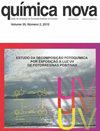FORMALDEHYDE ANALYSIS BY SPME ON-FIBER DERIVATIZATION: A STUDY OF THE KINETIC MODELS OF ADSORPTION FOR DIVINYLBENZENE
IF 0.5
4区 化学
Q4 CHEMISTRY, MULTIDISCIPLINARY
引用次数: 1
Abstract
Solid-phase microextraction (SPME) via on-fiber derivatization with O-(2,3,4,5,6-pentafluorobenzyl)-hydroxylamine (PFBHA) and gas chromatographic determination is considered a technique of choice in many analytical fields for formaldehyde (FA) monitoring. Vapor phase adsorption models of experimentally loaded PFBHA on porous divinylbenzene (DVB) SPME were investigated at 60 °C, 35 cm s-1 of air velocity, in a 1-64 min range: with the fiber completely exposed, loaded PFBHA was about 276 µg. Among the models tested, i.e. heat transfer, pseudo-second-order (PSO), Elovich, intra-particle diffusion, extra-particle diffusion and Langmuir, PFBHA adsorption was best fit by the PSO model, showing agreement with experimental data (272 µg). The sampling rate of FA in our conditions, obtained with a permeation tube system, was in agreement with literature (17.4 and 18.3 mL min-1, respectively). Thus, an overall standardization of the sampling phase is presented, leaving the sampling time as the most crucial parameter to be set for future applications.纤维上spme衍生化法分析甲醛:二乙烯基苯吸附动力学模型的研究
O-(2,3,4,5,6-五氟苯)-羟胺(PFBHA)纤维衍生固相微萃取(SPME)和气相色谱测定被认为是许多分析领域中甲醛(FA)监测的首选技术。在60°C、35 cm s-1风速、1-64 min的条件下,实验负载的PFBHA在多孔二乙烯基苯(DVB) SPME上的气相吸附模型进行了研究:在纤维完全暴露的情况下,负载的PFBHA约为276µg。在传热模型、伪二阶(PSO)模型、Elovich模型、颗粒内扩散模型、颗粒外扩散模型和Langmuir模型中,PSO模型最适合PFBHA吸附,与实验数据(272µg)吻合。在我们的条件下,通过渗透管系统获得的FA采样率与文献一致(分别为17.4和18.3 mL min-1)。因此,提出了采样阶段的整体标准化,将采样时间作为未来应用中最关键的参数。
本文章由计算机程序翻译,如有差异,请以英文原文为准。
求助全文
约1分钟内获得全文
求助全文
来源期刊

Quimica Nova
化学-化学综合
CiteScore
1.60
自引率
12.50%
发文量
72
审稿时长
2-4 weeks
期刊介绍:
Química Nova publishes in portuguese, spanish and english, original research articles, revisions, technical notes and articles about education in chemistry. All the manuscripts submitted to QN are evaluated by, at least, two reviewers (from Brazil and abroad) of recognized expertise in the field of chemistry involved in the manuscript. The Editorial Council can be eventually asked to review manuscripts. Editors are responsible for the final edition of QN.
 求助内容:
求助内容: 应助结果提醒方式:
应助结果提醒方式:


